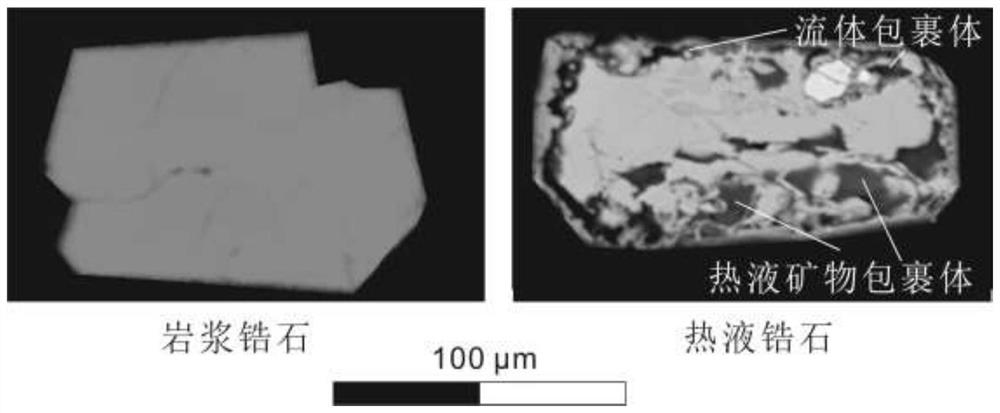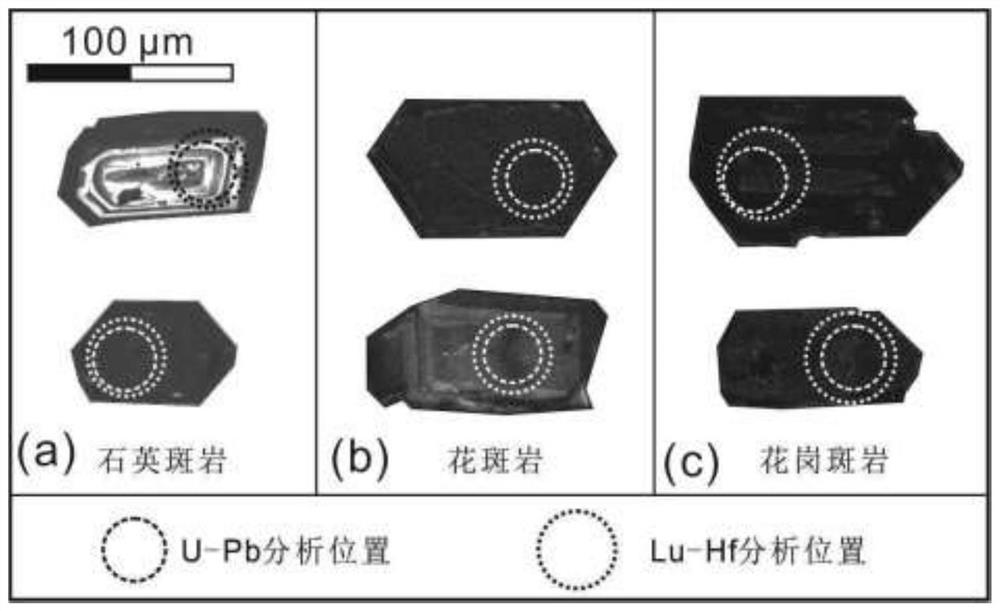A Mineral Exploration Method Using Zircons to Judge the Ore-Formation of Granite Body
A granite and zircon technology, applied in the preparation of test samples, material analysis using wave/particle radiation, sampling, etc. Considerable economic value, cost saving, and the effect of shortening the prospecting cycle
- Summary
- Abstract
- Description
- Claims
- Application Information
AI Technical Summary
Problems solved by technology
Method used
Image
Examples
Embodiment 1
[0073] Example 1 Analysis of different types of zircons in the granite of the tungsten-tin polymetallic deposit
[0074] Collect a variety of tungsten-tin metal deposits of granite, and make zircon markers, take CL images and BSE images of the markers obtained, compare and analyze the obtained images with the actual situation, and get the following figure 1 Typical CL images of different types of zircons shown and attached figure 2 Typical BSE images of different types of zircons shown. In the CL image, the left image is a typical magmatic zircon, which is white in color as a whole, and has obvious internal oscillation zones; the right image is a typical hydrothermal zircon, which is black in color and has no internal oscillation zones; The middle picture shows a sample containing both magmatic zircons and hydrothermal zircons. There are black and white parts at the same time, and there is an internal oscillation zone in the white part. In the BSE image, the left picture is...
Embodiment 2
[0075] Example 2 Using zircons to determine the mineralization of granite bodies in the Huangshaping tungsten-tin polymetallic deposit in Hunan
[0076] The inventor discovered granite bodies developed in multiple stages in the Huangshaping deposit where tungsten-tin deposits may exist, and selected three types of rock bodies that may be in contact with the ore bodies, namely quartz porphyry, porphyry and granite porphyry For analysis, the analysis process includes:
[0077] First, 100 zircon markers were randomly selected from each of the three types of granite for CL and BSE image capture.
[0078] According to the obtained CL images, there are a large number of clear oscillation rings in the zircons that account for more than 50% of the quartz porphyry and porphyry, as shown in the attached image 3 As shown in a and b, the overall luminous intensity of zircons accounting for more than 50% in granite porphyry is weak and appears black in the CL image, as shown in the attac...
Embodiment 3
[0087] Example 3 Using zircons to determine the mineralization of granite bodies in the Xianghualing tin-polymetallic deposit in Hunan
[0088] The inventor found many types of developed granite in the Laiziling pluton in Xianghualing, where tin-polymetallic deposits may exist, and selected two types of rocks that may be in contact with the ore body, namely albite granite and greisenized granite, for analysis. The analysis process is:
[0089] First, 100 zircons were randomly selected from three albite granite samples (XHL5-11, XHL6-2 and XHL7-3) and two greisenized granites (XHL5-16-2 and XHL6-18) as signage.
[0090] CL images and BSE images were taken for the above markers. According to the CL image, as attached Figure 8 As shown, it can be clearly seen that a large number of hydrothermal zircons with weak luminous intensity (appearing black in CL) are developed in the zircons in these two types of rock mass. More than 50%.
[0091] According to the BSE image, as atta...
PUM
| Property | Measurement | Unit |
|---|---|---|
| diameter | aaaaa | aaaaa |
Abstract
Description
Claims
Application Information
 Login to View More
Login to View More - R&D
- Intellectual Property
- Life Sciences
- Materials
- Tech Scout
- Unparalleled Data Quality
- Higher Quality Content
- 60% Fewer Hallucinations
Browse by: Latest US Patents, China's latest patents, Technical Efficacy Thesaurus, Application Domain, Technology Topic, Popular Technical Reports.
© 2025 PatSnap. All rights reserved.Legal|Privacy policy|Modern Slavery Act Transparency Statement|Sitemap|About US| Contact US: help@patsnap.com



